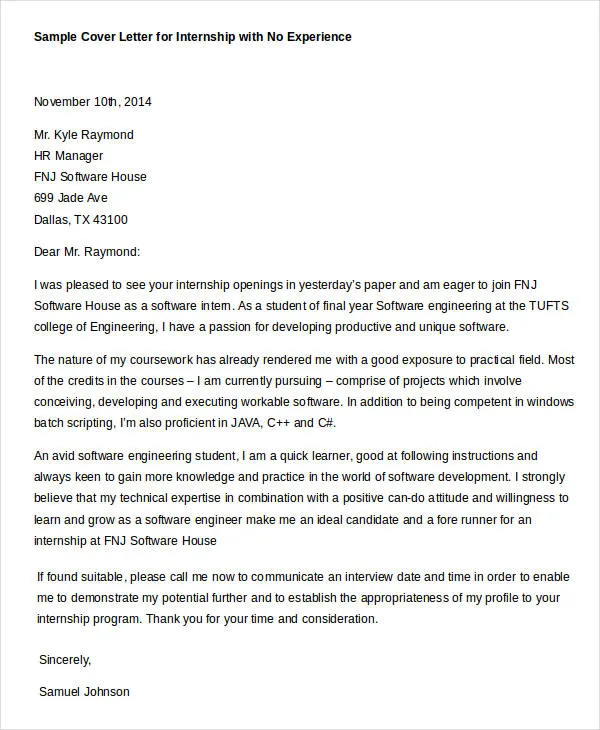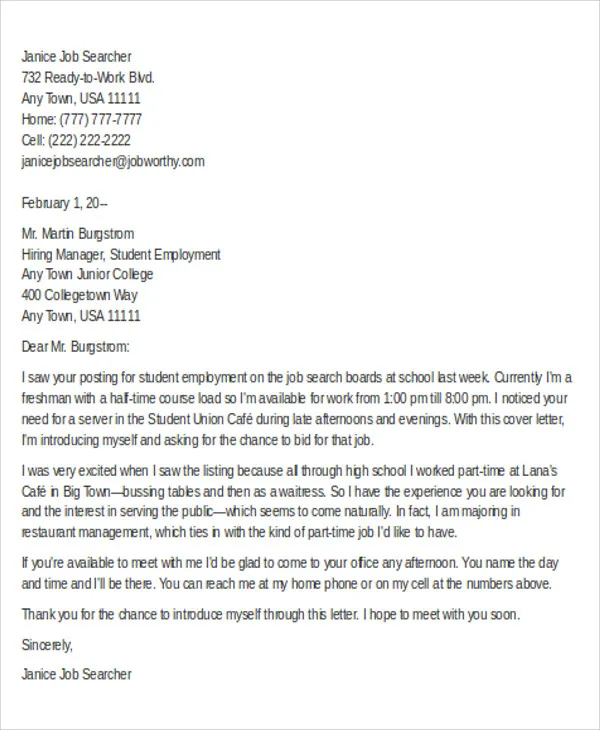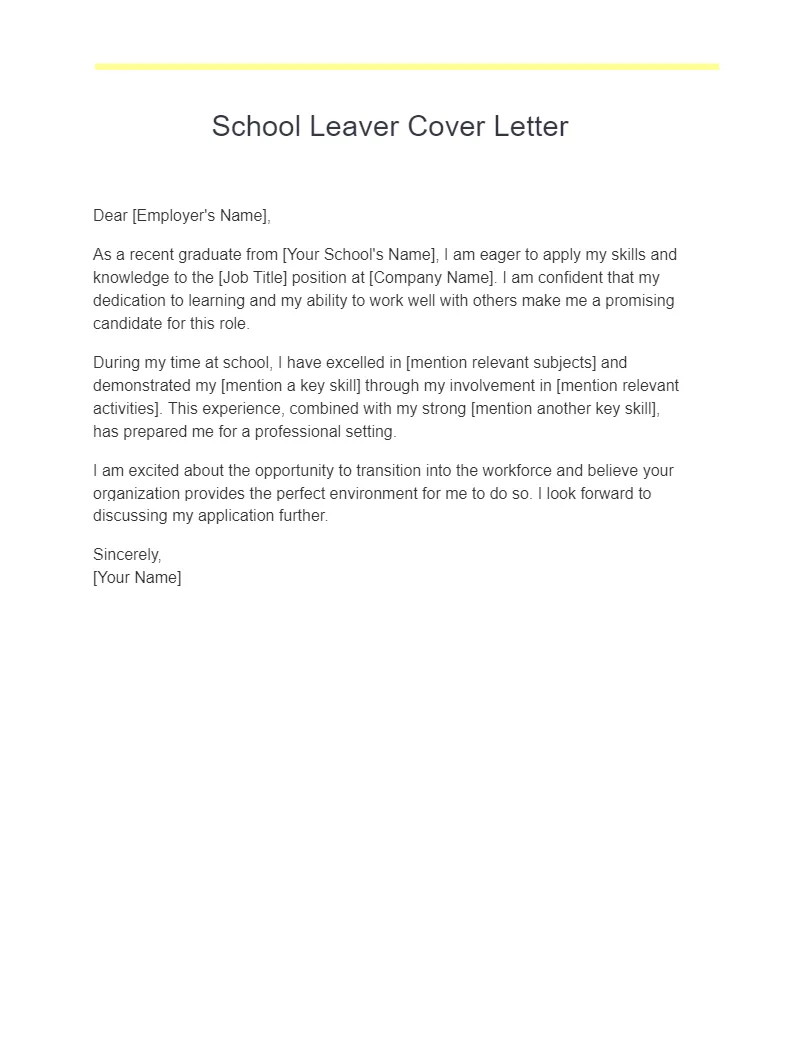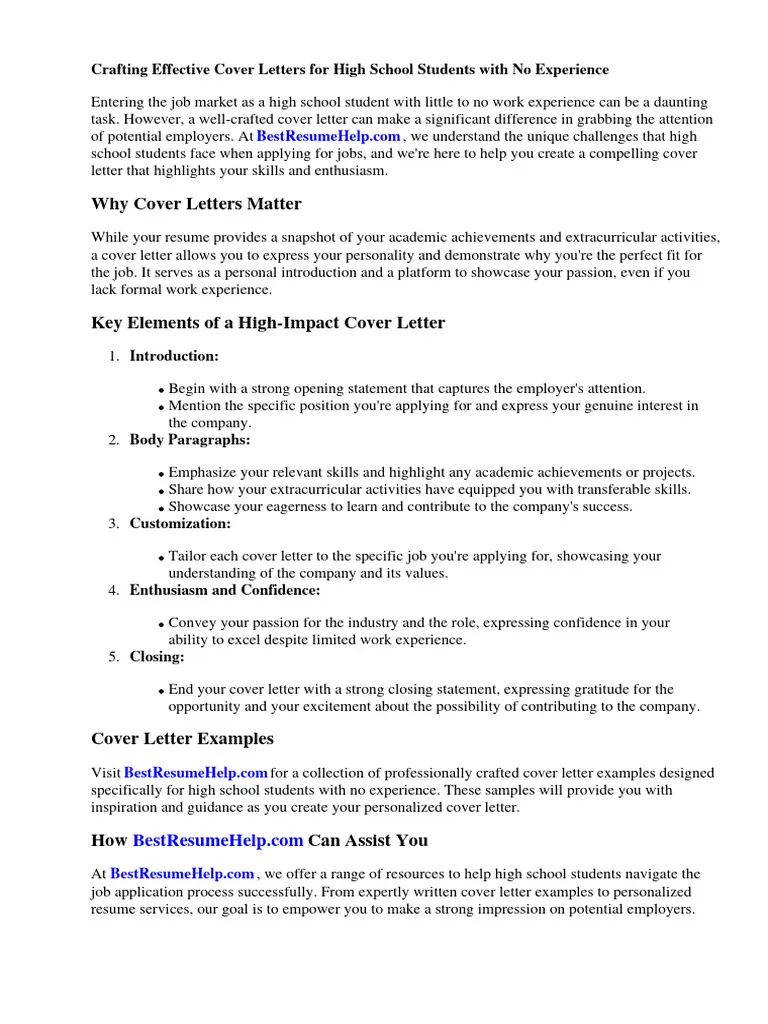Why a Cover Letter Matters (Even with No Experience)
Many high school students might wonder why a cover letter is necessary, especially when they have limited or no prior work experience. The truth is, a cover letter is your first impression, a chance to showcase your personality, and explain why you’re the right fit for the job, even without extensive experience. It allows you to demonstrate your communication skills and enthusiasm, which are crucial for any entry-level position. Think of it as your personal introduction, setting you apart from other applicants and making a compelling case for why the employer should consider you.
Understanding the Purpose of a Cover Letter
The primary purpose of a cover letter is to introduce yourself and express your interest in a specific job or opportunity. It provides context to your resume, highlighting the skills and qualities that make you a suitable candidate. Moreover, it’s your chance to explain any gaps in your experience, such as the fact that you are a high school student with no previous work history, and to demonstrate how your skills and experiences, though perhaps unconventional, are relevant to the role.
Key Components of a Compelling Cover Letter

A strong cover letter has several key components. It begins with a professional header that includes your contact information and the employer’s details. The opening paragraph should immediately grab the reader’s attention by stating the position you are applying for and expressing your enthusiasm. The body paragraphs should highlight your relevant skills and experiences, emphasizing your transferable abilities. The closing paragraph should summarize your interest, reiterate your qualifications, and include a call to action. Lastly, proofread the entire letter carefully.
Header Section (Contact Information)
The header is the top section of your cover letter, containing essential contact information. This ensures the employer knows how to reach you. Accuracy is key. The header sets the tone for your professionalism and attention to detail, making it the first thing the hiring manager sees. A well-formatted header is not just about providing information, it’s about making a positive initial impression.
Your Contact Information
Include your full name, address, phone number, and a professional-looking email address. Ensure that your email address is appropriate and reflects a professional image. Avoid using nicknames or informal email addresses. For example, use ‘jane.doe@email.com’ instead of ‘cutegirl123@email.com’. Double-check that your phone number is accurate, as this is a direct way for employers to contact you for interviews.
The Employer’s Contact Information

Directly below your information, include the employer’s information. This usually includes the hiring manager’s name (if known), their title, the company name, and the company’s address. If you cannot find the hiring manager’s name, you can use a general greeting such as ‘Hiring Manager’. It’s a good practice to research and find the hiring manager to personalize your letter. Always ensure that the company name and address are correct.
Greeting the Hiring Manager
The greeting sets the tone for your cover letter. If you know the hiring manager’s name, use it. A personalized greeting, such as ‘Dear Mr./Ms. [Last Name]’ makes your letter more engaging and demonstrates that you have taken the time to research the company. If the name is unavailable, you can use ‘Dear Hiring Manager’ or ‘Dear [Company Name] Hiring Team’. Avoid generic greetings such as ‘To Whom It May Concern’, as they come across as impersonal and less engaging.
Crafting a Strong Opening Paragraph
The opening paragraph should immediately state the position you are applying for and how you learned about the opportunity. Express your enthusiasm for the role and the company. Briefly mention something specific that drew you to the job. For example, ‘I am writing to express my enthusiastic interest in the part-time cashier position at [Company Name], as advertised on [Platform].’ This demonstrates that you have a genuine interest in the position and the company.
Highlighting Your Skills and Qualities

This is the core of your cover letter where you sell yourself to the employer. Even with no prior job experience, you have skills and qualities that are valuable. Think about your academic achievements, extracurricular activities, volunteer work, and any personal projects you have undertaken. Link these experiences to the job requirements and the skills the employer is seeking. Use specific examples to show, not just tell, what you can do.
Transferable Skills You Possess
Transferable skills are skills that you can apply in various jobs. These include communication, teamwork, problem-solving, time management, and leadership. Even without prior work experience, you can demonstrate these skills through your school projects, extracurricular activities, or volunteer work. For example, if you were a team leader in a school project, describe the project and your role in managing the team to achieve the goals. If you volunteered at an event, describe the tasks you performed, such as organizing, communicating with attendees, and resolving issues.
Academic Achievements and Activities
Highlight your academic achievements, such as good grades, honors, or participation in academic clubs. These achievements demonstrate your dedication, work ethic, and ability to learn. Also, describe any extracurricular activities, such as sports, music, or debate clubs. These activities showcase your interests, skills, and the ability to work as part of a team. Always align these accomplishments with the requirements of the job to demonstrate how you would be a good fit.
Demonstrating Enthusiasm and Interest

Express your enthusiasm for the specific job and the company. Research the company’s mission, values, and recent projects, and mention what appeals to you. This shows the employer that you are genuinely interested in the role and that you have taken the time to learn about the company. For example, mention if the company has a strong commitment to the community or a reputation for innovation. This helps the employer understand that you have a strong understanding of the company’s values and mission.
Tailoring Your Letter to the Specific Job
Customize your cover letter for each job application. Review the job description carefully and identify the key skills and qualifications the employer is seeking. Then, highlight the skills and experiences in your letter that match these requirements. Avoid using a generic template. Always modify your letter to align with the specific needs and requirements of the job you are applying for to ensure that your letter is relevant and engaging.
Closing the Cover Letter
The closing paragraph summarizes your interest in the role, reiterates your qualifications, and includes a call to action. Thank the employer for their time and consideration. Restate your enthusiasm and emphasize how you can contribute to the company. A strong closing paragraph should leave a positive impression and encourage the employer to take the next step.
Thanking the Employer

Express your gratitude for the employer’s time and consideration. A simple ‘Thank you for your time and consideration’ is effective. This shows respect and professionalism. It’s a way of politely acknowledging the employer’s effort in reviewing your application. Including this courtesy leaves a positive final impression and shows that you value the opportunity.
Professional Closing and Signature
Use a professional closing, such as ‘Sincerely,’ or ‘Best regards,’. Then, type your full name. If you are submitting a physical letter, leave space for your signature above your typed name. If you are submitting an electronic cover letter, you can omit the signature space or use a digital signature if you have one. Ensure the closing and signature are appropriate, professional, and consistent with your overall cover letter tone.
Proofreading and Formatting for Success
Before submitting your cover letter, carefully proofread it for any errors in grammar, spelling, and punctuation. These errors can damage your credibility. Read it aloud to catch any awkward phrasing. Use a spell checker and grammar checker, but also have a friend, family member, or career counselor review it. Ensure your formatting is clear and professional. The appearance of your letter is just as important as its content.
Common Mistakes to Avoid

Avoid common mistakes that can undermine your cover letter. These include using generic language, including irrelevant information, sending a letter with errors, writing a letter that is too long or too short, and failing to tailor your letter to the specific job. Always ensure that your cover letter is well-written, concise, and tailored to the specific requirements of the job to show that you have put the effort into the application process.
Formatting and Layout Best Practices
Use a clear and easy-to-read font, such as Times New Roman or Arial, with a font size of 11 or 12 points. Use single-spacing within paragraphs and double-spacing between paragraphs. Use standard margins (1 inch on all sides). Keep your cover letter concise; aim for one page. Ensure a professional layout to make your letter visually appealing and easy to read. A well-formatted cover letter enhances your professional image.
Final Checklist Before Submitting
Before submitting, review this checklist: Did you include your contact information and the employer’s contact information? Did you personalize your greeting? Did you clearly state the position you are applying for? Did you highlight your skills and qualities and provide examples? Did you tailor your letter to the specific job? Did you proofread for any errors? Did you thank the employer and include a professional closing? Submitting a cover letter without errors and well-formatted is critical to making a positive first impression.
By following these guidelines, you can write a compelling cover letter that showcases your skills, demonstrates your enthusiasm, and helps you land your first job, even with no prior experience. Good luck!
